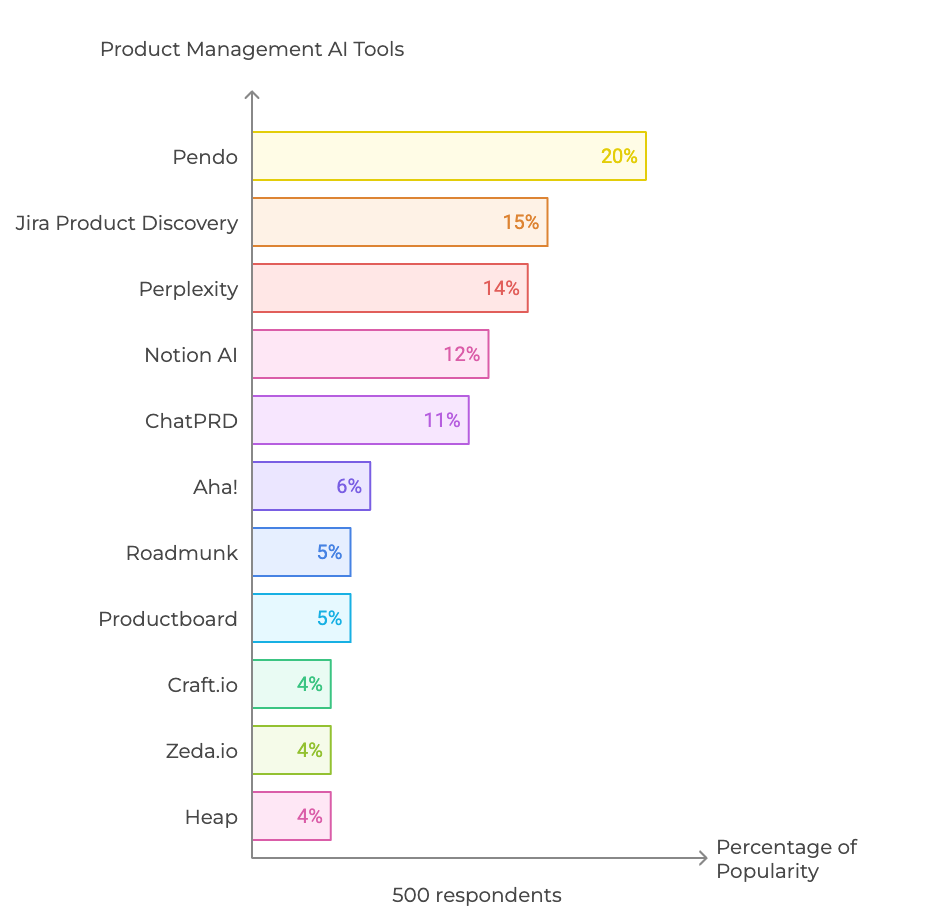A few weeks ago, we sent out a few polls to find out what tools the product community have found the most valuable to use over the past 12 months. Based on feedback from over 500 responses, here’s what we found were the most valuable tools for product people to use.

Jira Product Discovery
Kicking off this list is Jira Product Discovery, with 15% of respondents listing this as their go-to tool.
Jira Product Discovery lets product teams capture and prioritize ideas and align everyone with product roadmaps. It excels at helping teams manage product backlogs, track progress, and collaborate across departments.
Key features:
- Idea Management: Centralize and prioritize ideas from various sources.
- Roadmapping: Develop visual roadmaps connected to actionable tasks.
- Integration: Integrate with other Jira tools, enhancing overall project management efficiency.
Pendo
One in five (20%) of respondents have rated Pendo as their most valuable tool, making it the leading choice in user engagement and analytics.
Pendo is designed to help product managers understand user behaviour, collect feedback, and drive product adoption. Its analytics and in-app messaging features are particularly valuable for enhancing user experience.
Key Features:
- User Analytics: In-depth insights into user interactions.
- In-app Messaging: Directly communicate with users through guides and surveys.
- Feedback Collection: Gather and analyse user feedback to inform product decisions.
Notion AI
Another popular option for product professionals is Notion AI, particularly for managing documentation and information, with 12% of product people choosing this as their go-to tool.
Notion AI enhances the functionality of the Notion workspace by automating tasks such as content creation, summarization, and organization. This makes it an indispensable tool for product managers handling extensive documentation.
Key features:
- Automated Summaries: Quickly summarise meetings and documents.
- Content Generation: Use AI to draft product briefs, specifications, and more.
- Database Integration: Link AI-generated content with Notion’s databases for streamlined management.
Perplexity
Perplexity is a new tool in the market that has been received well so far. 14% of respondents selected it as a valuable AI-driven tool in product management.
Perplexity stands out for its AI capabilities, particularly in generating insights and recommendations that support data-driven decision-making. It's ideal for product managers who need to quickly interpret large datasets.
Key features:
- Insight Generation: AI-driven insights from extensive data analysis.
- Recommendation Engine: Suggests next steps based on current metrics and user behaviour.
- Automation: Automates routine tasks, allowing product managers to focus on strategic initiatives.
ChatPRD
ChatPRD a new product in the market, is proving to be a valuable tool for enhancing team communication and documentation through AI.
The new AI tool leverages AI to streamline communication and documentation within product management teams. It’s particularly useful for real-time collaboration and automating the creation of product documentation.
Key features:
- Real-Time Collaboration: Facilitates seamless communication among team members.
- Automated Documentation: Automatically generates and updates product documentation based on discussions.
- Integration: Integrates with other project management tools, ensuring everyone stays on the same page.
A few weeks ago, we interviewed Claire Vo, Founder of ChatPRD. Check out the full article here.
Aha!
The product community has also identified Aha! as a critical tool for strategic product roadmaps, with 6% of respondents citing it as an important tool.
Aha! is a powerful tool for defining strategy, setting goals, and creating detailed roadmaps. It’s designed to help product managers align their teams around a shared vision and track progress toward key objectives.
Key features:
- Strategy Mapping: Visualize and communicate your product strategy.
- Goal Tracking: Set, manage, and measure progress against goals.
- Roadmapping: Create strategic roadmaps that guide product development.
Roadmunk
Another favoured tool is Roadmunk, for its strength in roadmapping and visual planning.
Roadmunk is a tool for creating and sharing visual roadmaps. It’s particularly valued for its ability to help teams communicate product plans and timelines clearly to stakeholders.
Key features:
- Roadmap Visualisation: Create visually engaging roadmaps.
- Collaboration Tools: Share roadmaps with stakeholders for feedback and alignment.
- Customization: Tailor roadmaps to suit specific audiences and needs.
Productboard
Productboard has also been noted for its suite of product management software tools that help product managers understand customer needs, prioritise features, and rally everyone together on the product journey.
Key features:
- Prioritisation Frameworks: Built-in frameworks for feature prioritization.
- Customer Feedback Integration: Link feedback directly to your product roadmap.
- Roadmapping: Communicate your product vision through detailed roadmap
Craft.io
Craft.io is a digital workspace designed for teams to collaborate on various projects and tasks. It allows users to create custom dashboards, automate workflows, and track progress.
Key features:
- Roadmapping: Develop and share strategic roadmaps.
- User Story Mapping: Visualize the user journey and plan product features accordingly.
- Collaboration: Enable team collaboration with integrated tools for communication and feedback.
Zeda.io
Zeda.io is a valuable tool for managing product development and prioritisation, with 4% of respondents choosing this for product tasks.
Overview: Zeda.io focuses on simplifying product management assignments by providing tools for roadmapping, feature prioritization, and team collaboration, all within a single platform.
Key features:
- Prioritization Tools: Prioritize features and tasks based on impact and effort.
- Roadmapping: Create and share clear product roadmaps with stakeholders.
- Collaboration: Enhance team collaboration with integrated communication tools.
Heap
Finally, the community highlighted Heap, particularly for its analytics insights capabilities.
Overview: Heap is an advanced analytics tool that automatically captures every user interaction, providing product managers with deep insights into user behavior and product performance.
Key features:
- Automatic Data Capture: Track all user interactions without manual event tagging.
- User Journey Analysis: Understand how users navigate through your product.
- Advanced Segmentation: Segment users based on behavior, enabling more targeted analysis.
Any tools that you would recommend using as a product manager? Let us know in the comments below or on LinkedIn!









Comments
Join the community
Sign up for free to share your thoughts